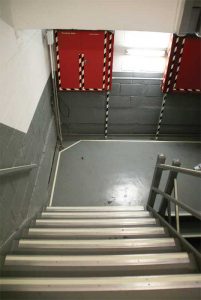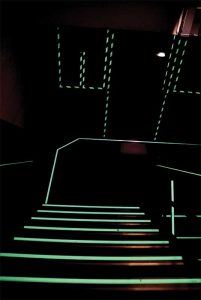Photoluminescent Egress: A Critical Safety Specification
by Samantha Ashenhurst | June 17, 2018 9:15 am
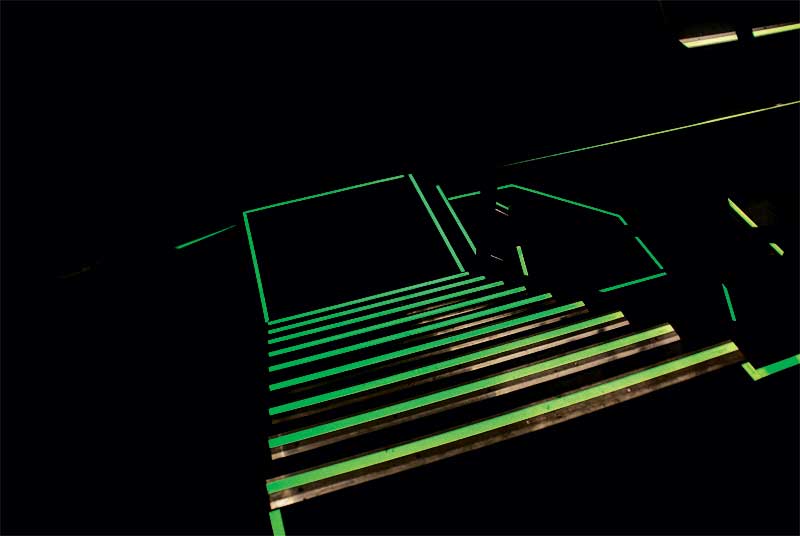 [1]
[1]by John M. Harder
Guiding occupants out of a smoke-filled or darkened building via luminescing egress demarcation could save lives in an emergency. Specifying photoluminescent (PL) egress products in commercial buildings is required by building codes, but should also be done with care to ensure the selected materials provide durability and long-term performance. Doing so could mean the difference between life or death for occupants exiting a facility during a fire, power outage, or other catastrophe.
PL systems are now considered critical components in an effective egress system. While emergency electrical lighting has long been a staple of facility life-safety systems, it is not failsafe since a catastrophe can potentially interrupt its link to the emergency power supply. In contrast, PL stair nosings, pathway markings, and exit signs and demarcation are not subject to power outages. Instead, they rely on PL pigmentation charged by natural or artificial light sources, such as sunlight, fluorescent, incandescent, and light-emitting diode (LED) fixtures. The charge allows the pigments to instantaneously glow bright enough to lead occupants out of a facility when electric or natural light sources fail.
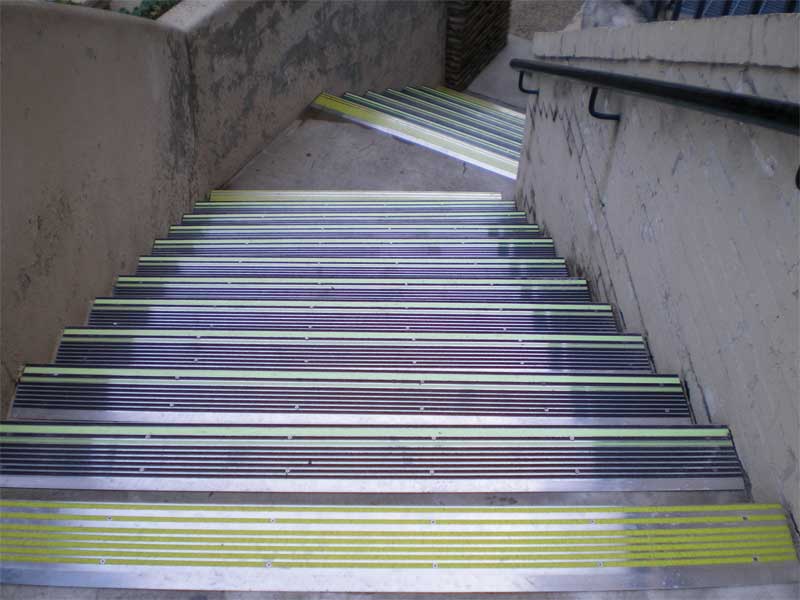 [2]
[2]The PL pigments consist of crystals charged by storing light photons when exposed to natural or artificial light. Once charged, the energy stored in the crystals slowly exhausts until it is completely depleted. This slow release allows products using the pigment to emit light for extended periods of time. The material is continually recharged by exposing it to a light source.
Pigment technology has become so advanced some industry studies suggest it can potentially be employed as an alternative to the more expensive emergency electrical lighting egress systems. (For more, read “Literature Review on Photoluminescent Material Used as a Safety Wayguidance System” by R. Tonikian, G. Proulx, N. Bénichou, and I. Reid, and published by The National Research Council Canada [NRC].)
Advancements in PL technology
The notion PL products might someday qualify as an emergency electric lighting alternative demonstrates the technology has come a long way. Most modern PL products use the patented phosphorescent chemical, strontium aluminate oxide. It is 10 times brighter, and lasts 10 times longer than its predecessor, copper-activated zinc sulfide (ZnS), which was the convention of PL 25 years ago.
The glow duration and brightness of PL products depend on the length and intensity of the light exposure. For this reason, the International Building Code (IBC) has adopted two test standards to set the bar for performance of PL products in egress applications. Products must meet either Underwriters Laboratories (UL) 1994, Luminous Egress Path-marking Systems, or ASTM E2072, Standard Specification for Photoluminescent (Phosphorescent) Safety Markings. These standards dictate the brightness and exposure time of the charging light, the decay time once the charging light is removed, and the performance expectations of the product at the end of this time. Both standards require a 60-minute exposure to an 11-lux (1-footcandle) light source and a 90-minute decay time. However, they differ in how they measure performance. UL 1994 requires the markings to be distinguishable from a defined distance, while ASTM mandates a specific luminance reading at particular time intervals. These tests recreate the potential low-light conditions in the stairwell corners.
| CODES FOR PHOTOLUMINESCENT EGRESS |
Important building code sections requiring photoluminescent (PL) exit path markings are:
Photoluminescent stairway identification signs shall be included in interior exit stairways. This is effective from January 2009.
Photoluminescent markings shall be provided in interior exit stairways of building types A, B, E, I, M, and R-1. This section became effective in January 2009.
Effective from January 2009, the section makes photoluminescent exit stair path markings optional for all buildings, new and existing, regardless of height.
Required in occupancies in exit corridors leading to emergency exit stairwells. This was made effective in January 2008.
Required in all new and existing buildings, and effective from March 2005. |
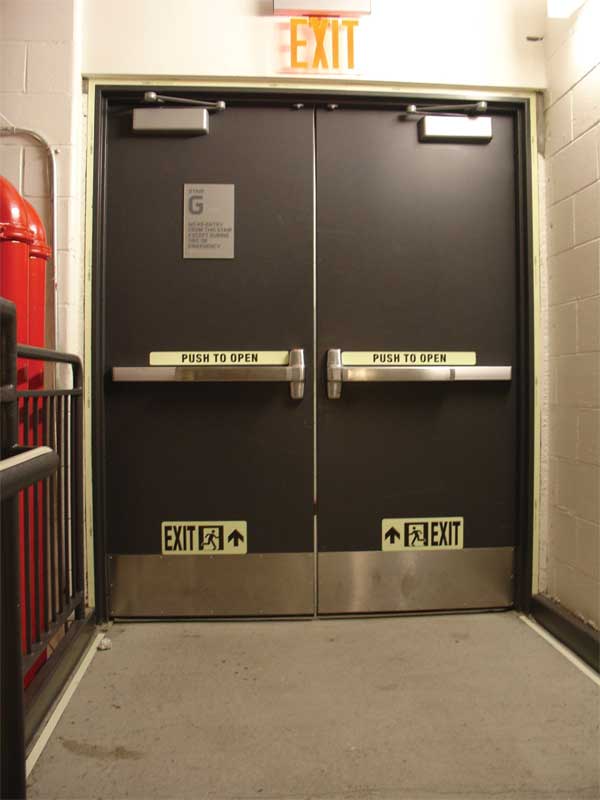 [3]
[3]History proves performance
Prior to the 1990s, PL lighting was more of a novelty and not considered bright or long-lasting enough to function as an egress marking. Emergency electrical lighting was considered sufficient for providing lighting and exit strategies during catastrophes.
However, a catastrophe opened new discussions regarding the possibilities of PL egress markings. The 1993 World Trade Center bombing provided a sobering indication electrical systems alone were insufficient because the building’s emergency lighting system was damaged, impeding egress for some of the occupants. It became clear egress routes needed to be designated with markings not reliant on external power sources. Around this time, significant advancements were made in PL technology enabling it to provide a longer-lasting afterglow. Consequently, the World Trade Center was one of the first facilities to employ PL as an egress path marker in the late 1990s.
In 2001, the 9/11 World Trade Center attack put the PL system to the real test. Survivors listed the PL markings as one of the top three things that helped them exit the building safely. At the Pentagon where PL demarcation was not yet in use, survivors reported difficulty exiting. (For more information, read the article, “A Brief History of Photoluminescent Marking,” published by Building Operating Management Magazine.)
The 9/11 attack prompted a number of PL installations and requirements for the material in building codes. For example, the United Nations installed PL pathway markings in 2003; New York City passed Local Law 26, which mandated PL pathway markings in all high-rise office building stairwells by 2006; and the International Code Council (ICC) adopted a PL pathway marking in a variety of building types as part of its 2009 IBC.
Selecting a PL system
While PL is required in many building codes, and its luminance performance is governed by test standards, there are still important decisions specifiers and contractors must make. One such decision is the quality of PL product. If people are to egress the building safely, not only days, but years after the material has been installed, then the durability of the specified product has a major impact on occupant safety. Unfortunately, life-safety products are often downgraded as a part of larger efforts to reduce total project cost. While looking for cost-saving opportunities is good from a project management standpoint, it should never compromise a building’s life-safety systems.
Since IBC’s adoption of PL egress requirements in 2009, many code-compliant products have entered the market, providing luminescent markings on a wide range of media from thin tape/films to extruded plastic or aluminum.
Tapes/films typically have an ultra-thin adhesive coating on one side for easy peel-and-stick installation. They are less expensive but require more maintenance. They excel in adhesion to smooth substrates, such as metals, but can have difficulties on concrete where the surface is not as smooth as metals and requires careful cleaning to remove dust. Further, they wear much quicker under foot traffic. The use of these products in such an application can result in worn or missing markings, which leaves the intended PL egress pathway poorly defined and subject to a potential code violation and liability. The expected short life cycle of tapes/films leaves the facility unprotected if the building maintenance staff does not carefully maintain and reapply damaged tape/film sections.
Coated aluminum strips provide a much stronger, longer-lasting marking system for foot traffic applications. In contrast to the thin adhesive film, these products are either mechanically fastened or adhered in place with a viscous construction adhesive. The aluminum backing provides a robust substrate for the PL material withstanding the daily abuse of foot traffic. Additionally, these strips can be mounted into a stair nosing, thereby protecting the stair edge and increasing its slip resistance. Most manufacturers provide extended warranties for this type of product and some guarantee effective charge/glow cycles for as long as 25 years.
Another important consideration is the ability to keep the PL material clean. If not rigorously maintained, products trapping dirt onto the PL surface will quickly suffer loss in performance. This is the case with products integrating the PL pigment directly into a rough tread insert. While this material is ideal for providing slip resistance, it should be used in conjunction with separate, smooth PL strips (e.g. aluminum demarcation strips) featuring a smooth coating that does not actively collect dirt and is easy to wipe clean.
Finally, areas outside of code-driven egress applications such as stairs in stadiums, plazas, and other outdoor facilities can be effectively marked with PL systems. In these cases, it is important to ensure the PL strip has been tested to UL 1994 for outdoor use. Since most products were developed strictly with indoor egress applications in mind, there are few materials designed to withstand ultraviolet (UV) light exposure. Products listed for outdoor use in accordance with UL 1994 are required to be exposed to UV light for an extended period of time and suffer no more than 10-percent loss in luminance performance.
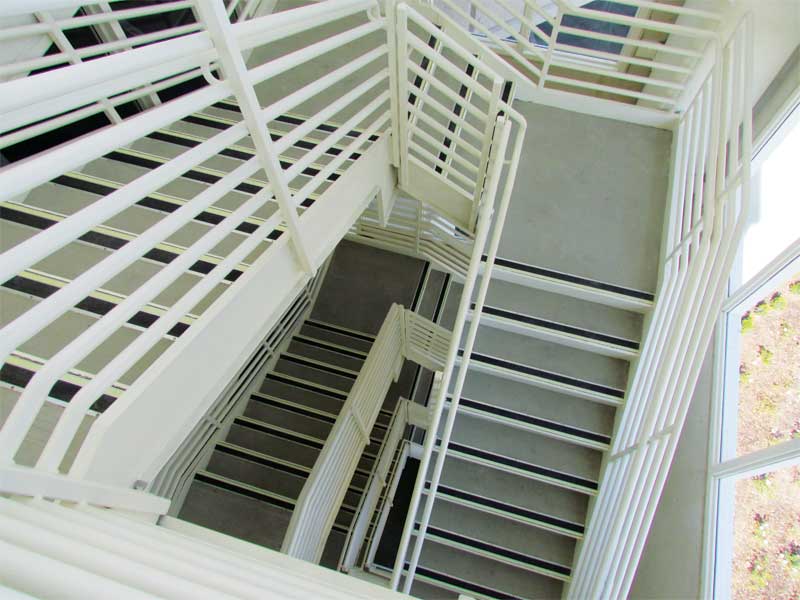 [6]
[6]Other considerations
While there are many materials, methodologies, and installation styles specifiers must choose from, test standard certifications can help determine which products satisfy code and provide long-lasting performance in the application.
In addition to those already mentioned, other test standards important to consider are:
- Bombardier SMP 800C, Toxicity;
- flame spread as per ASTM D635, Standard Test Method for Rate of Burning and/or Extent and Time of Burning of Plastics in a Horizontal Position;
- salt spray resistance as per ASTM B117, Standard Practice for Operating Salt Spray (Fog) Apparatus;
- slip resistance as per UL 410, Certification for Slip Resistance of Floor Surface Materials;
- nonradioactive qualities as per ASTM D3648, Standard Practices for the Measurement of Radioactivity; and
- UL 1994 or ASTM E2072 testing with a specific lighting type (e.g. LED and fluorescent).
Conclusion
While employing PL egress path markings is typically required by code, a greater level of life safety can be provided to occupants when the best-suited product is selected for the project. It is important to consider durability, wear, and unique conditions such as UV exposure when selecting the product. When properly selected, PL systems ensure safe egress of occupants and provide peace of mind to building owners.
John M. Harder is senior manager of quality and engineering services for Balco USA, a Kansas-based manufacturer of construction product specialties. Harder was integral in the design of Balco’s product line of photoluminescent (PL) stair nosings, aluminum strips, exit path markings, signage, and other egress path products. Harder can be reached via e-mail at john.harder@balcousa.com[7].
- [Image]: https://www.constructionspecifier.com/wp-content/uploads/2018/06/A-PL-demarcation-at-NY-Time-Warner-Bldg.jpg
- [Image]: https://www.constructionspecifier.com/wp-content/uploads/2018/06/F-San-Antonio-TX-Riverwalk-with-Stair-nosing-PL.jpg
- [Image]: https://www.constructionspecifier.com/wp-content/uploads/2018/06/D-Exit-Door-with-aluminum-strip-PL-demarcation.jpg
- [Image]: https://www.constructionspecifier.com/wp-content/uploads/2018/06/Bb-NY-Time-Warner.jpg
- [Image]: https://www.constructionspecifier.com/wp-content/uploads/2018/06/B-NY-Time-Warner-PL62.jpg
- [Image]: https://www.constructionspecifier.com/wp-content/uploads/2018/06/Gg-high-angle-John-Wayne-Airport-Orange-County-Calif.jpg
- john.harder@balcousa.com: mailto:john.harder@balcousa.com
Source URL: https://www.constructionspecifier.com/photoluminescent-egress-a-critical-safety-specification/
 [4]
[4]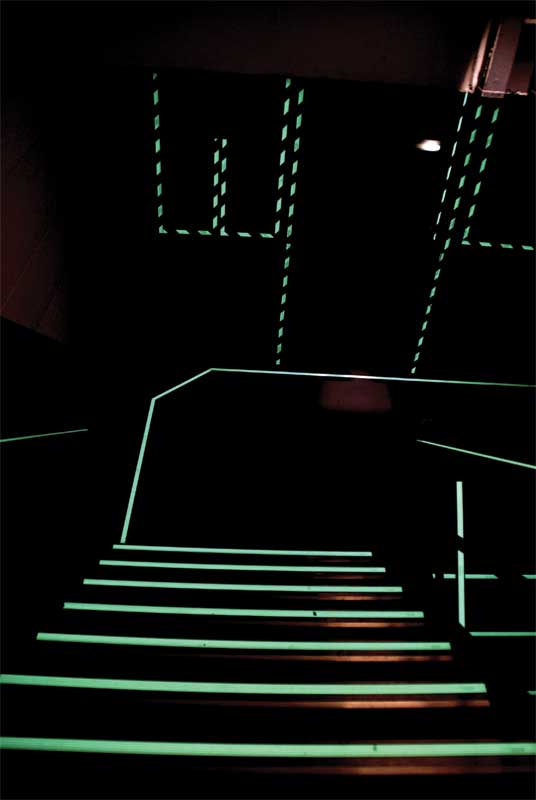 [5]
[5]